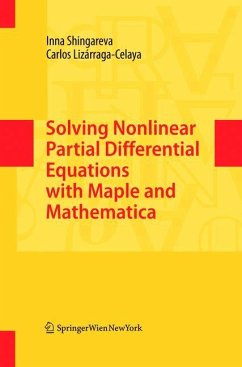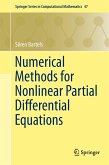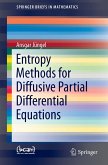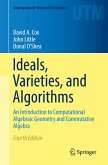The emphasis of the book is given in how to construct different types of solutions (exact, approximate analytical, numerical, graphical) of numerous nonlinear PDEs correctly, easily, and quickly. The reader can learn a wide variety of techniques and solve numerous nonlinear PDEs included and many other differential equations, simplifying and transforming the equations and solutions, arbitrary functions and parameters, presented in the book). Numerous comparisons and relationships between various types of solutions, different methods and approaches are provided, the results obtained in Maple and Mathematica, facilitates a deeper understanding of the subject. Among a big number of CAS, we choose the two systems, Maple and Mathematica, that are used worldwide by students, research mathematicians, scientists, and engineers. As in the our previous books, we propose the idea to use in parallel both systems, Maple and Mathematica, since in many research problems frequently it is required to compare independent results obtained by using different computer algebra systems, Maple and/or Mathematica, at all stages of the solution process. One of the main points (related to CAS) is based on the implementation of a whole solution method (e.g. starting from an analytical derivation of exact governing equations, constructing discretizations and analytical formulas of a numerical method, performing numerical procedure, obtaining various visualizations, and comparing the numerical solution obtained with other types of solutions considered in the book, e.g. with asymptotic solution).
From the reviews:
"The authors consider the problem of constructing closed-form and approximate solutions to nonlinear partial differential equations with the help of computer algebra systems. ... The book will be useful for readers who want to try modern methods for solving nonlinear partial differential equations on concrete examples without bothering too much about the mathematics behind the methods. Thus it is mainly of interest for applied scientists. Mathematicians may use it in connection with more theoretical works; some references are given throughout the book." (Werner M. Seiler, Zentralblatt MATH, Vol. 1233, 2012)
"The authors consider the problem of constructing closed-form and approximate solutions to nonlinear partial differential equations with the help of computer algebra systems. ... The book will be useful for readers who want to try modern methods for solving nonlinear partial differential equations on concrete examples without bothering too much about the mathematics behind the methods. Thus it is mainly of interest for applied scientists. Mathematicians may use it in connection with more theoretical works; some references are given throughout the book." (Werner M. Seiler, Zentralblatt MATH, Vol. 1233, 2012)








